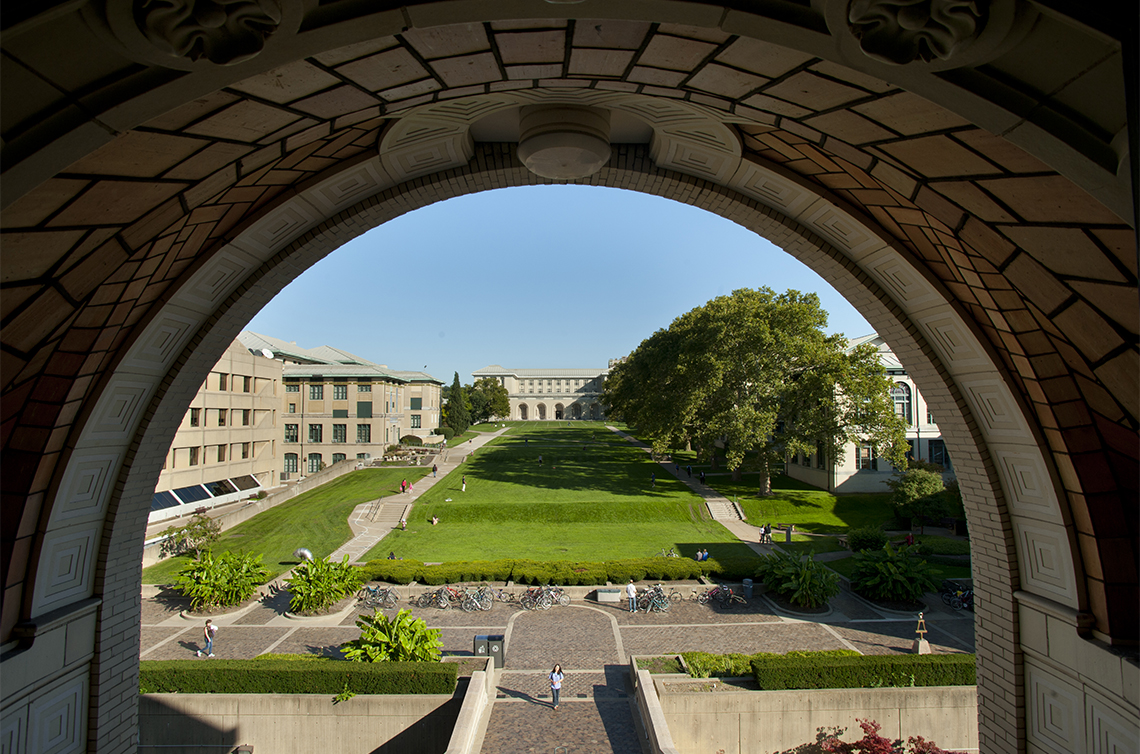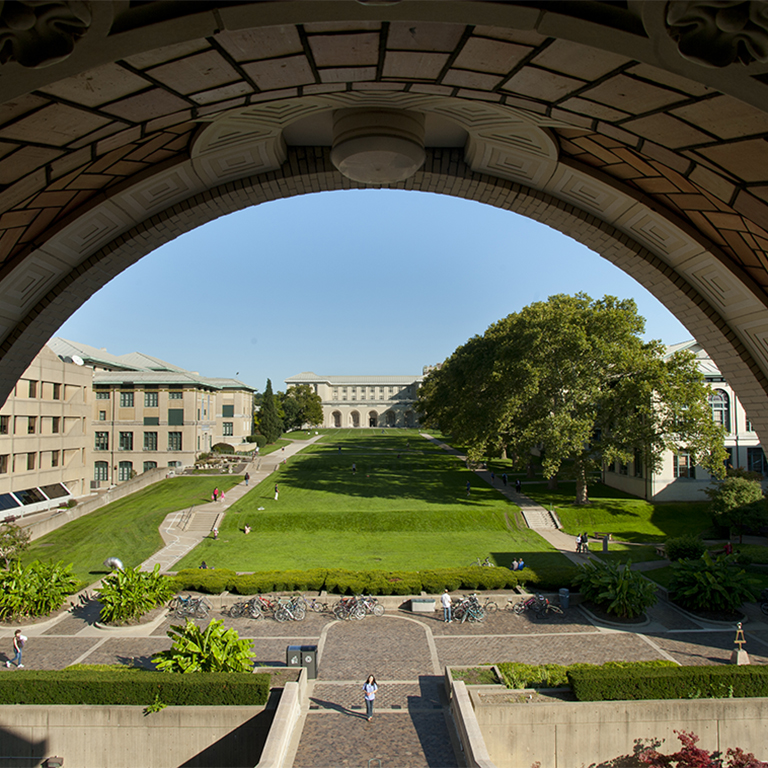
In celebration of the School of Art’s annual tradition, artist and educator Coco Allred (BFA ’20) draws inspiration from “dream clouds” — combining creativity, play, and community.
Since graduating from The Carnegie Mellon School of Art in 2020, Coco Allred has worked as a teaching artist in Philadelphia, Seattle, and abroad, designing hands-on projects that invite students of all ages to discover new ways of seeing and making. She is now pursuing her master’s degree at MIT, where she continues to expand her interdisciplinary practice. Her work has taken her from residencies in Italy, where she immersed herself in Reggio Emilia pedagogy, to Lithuania, where she recently taught workshops, learned natural dyeing, and collaborated with local artists and educators.
This summer, that philosophy extended back to CMU as Allred designed the School of Art’s 2025 T-shirt. Inspired by the ritual of starting a new learning experience, her design soars with both a childlike levity and a poignant reminder to simply let go and play. In the conversation below, Allred reflects on her path since CMU and what it means to design for a community she still calls home.

DESIGNING THE 2025 T-SHIRT
The School of Art’s T-shirt tradition is now in its fifth year, with a different alum commissioned each time to mark the start of a new academic year. This annual project celebrates alumni creativity, connecting past and present students, including the four previous participants Steven Montinar (BFA ’21), Rosabel Rosalind (MFA ’23), Christina Lee (BFA ’14), and Huidi Xiang (MFA ’21).
How did you want to approach the concept for this year’s shirt?
CA: I was interested in the ritual of getting the shirt at the beginning of the year, as a welcome into the school. I often look to children for guidance and inspiration in my creative practice. The design is really simple — like a scribble, which we can see as a cloud or something else. I wanted something with a sense of levity that felt accessible. I think everyone can and should draw for the sake of learning — drawing to absorb a place or understand an idea. I wanted the design to feel like an invitation, a reminder to myself and others to go back to modes of making that feel easy and are a form of play and relaxation.
You call these “dream clouds” — why?
CA: My interest in clouds came during the pandemic, as something I could reliably look up to for beauty and awe. I started collaborating with PhD atmospheric science students at the University of Washington, teaching observational drawing and learning about clouds. It was this one day in July with just endless blue sky, a perfect day. I had all of these people prepared to draw clouds, and then we had no clouds. So yeah, we drew dream clouds. The inspiration for the design came from these drawings — chaotic, individualized, with a sense of motion, but just one simple line.
What’s significant about the steely blue color you chose?
CA: I like that it’s not as cheerful as some other blues you might associate with children’s drawings. Both Seattle and Pittsburgh have gray-blue skies, so it’s about finding beauty in that. I wanted something neutral, something people are happy to wear, and a little more understated.

THE IMPORTANCE OF PLAY
Allred’s approach to teaching and making is informed partly by her time working at a Reggio school in Ponzano, Italy, in 2022, where she says she was captivated by the emphasis on documentation and listening to children explain their creative process. She has also engaged with Reggio Emilia principles through Harvard’s Project Zero, which has studied the approach for over 30 years.
What impact did your Reggio experience have on your practice?
CA: That time in Italy was really important. I went from being fully immersed as an art educator to a residency where I could invest in my own practice and think about what I wanted to do and what I learned from teaching. I became interested in pedagogy as both a practitioner and a researcher. I started thinking about “recursive kindergarten,” where you’re doing the same thing over and over, maybe with more complexity, but the same lessons and problems. Having a sense of play is important to me. If I have a fixed image of the outcome, I know I’m not in play. Play is about being open to surprises and willing to dance with what comes. I’ve worked with people of all ages and learned a lot from working with adults — how to get them to participate and find themselves in play.
How do you get adults to play?
CA: Part of it is starting small. I was teaching drawing as a cognitive process, more about reflection as an individual, in groups, and in response to the environment. I played a game like musical chairs, setting a timer for 30 seconds. When people don’t have a drawing practice, they focus on making something that looks good, but with unreasonable conditions — no time, no ability to erase, no ownership over a drawing — it becomes about process. At first, people are uncomfortable, but after a couple of minutes, they start to ease in. Play needs the right amount of challenge to feel worthwhile and exciting.
THE SCHOOL OF ART
Allred graduated in 2020 with a BFA in Sculpture and a minor in Human-Computer Interaction. Today, her work spans multiple media, from sculpture and printmaking to collaborative public projects, reflecting a curiosity-driven approach that bridges research and hands-on practice.
How did you decide to come to CMU?
CA: I wanted to be in an arts program that was important to the school’s culture, not just a department. At Carnegie Mellon, art is really valued, and it’s a place where concept and research are really valued. When I visited, I just knew it was the right spot. I could chase ideas and build skills to make work where the medium served the ideas. I had support to try anything out and take on big challenges. Art was seen as a mode of research and investigation, a way to foster empathy and connection.
Where did you feel most challenged?
CA: I really grappled with what it means to make things in public, taking classes with John Carson, Kim Beck, Isla Hansen, and Imin Yeh. Working in public was intimidating, but it was unique for that to be a requirement.
LIFE AFTER CMU
Since graduating, Allred has continued to develop her practice through residencies and collaborations. In 2023, she partnered with Anthropologie to create a candle capsule collection, donating 100% of sales to YoungArts. That same year, she was a resident at Fabrica in Treviso, Italy, and has completed apprenticeships at the Fabric Workshop Museum in Philadelphia and a Work Trade Residency at A-Z West in Joshua Tree, CA. Allred is now studying for her master’s at MIT.
How central is technology to your work at MIT?
CA: I don’t default to technology as a medium, though sometimes it comes up. At MIT, I’m the one saying basket weaving is technology, teaching it at an architectural scale to engineers, and having conversations about where these practices come from and what we can learn. I’m very process-based — how it’s made, under what conditions, with whom, why, and where all these things come from. I’m interested in moments of convergence between craft and technology. When we understand something is designed, we can think about how it can be redesigned and what values it reflects. That’s how I approach it — bringing both worlds together to make craft and technology more accessible.
What advice would you share with a recent grad or with a first-year student just starting at CMU?
CA: Going to art school is an incredible gift, given to you by your peers, teachers, family, and yourself. Don’t forget that. I had a lot of questions about continuing as an artist and investing in my practice. Don’t pigeonhole yourself — leave time to discover what you want to make and what your process looks like. I was glad I didn’t try to monetize or shift my practice in response to outside conditions right away. For a First-Year student, try to keep track of your intuition — what decisions you’re making and why. I remember being assigned to write about all our projects, and it often felt like a chore, but looking back, it helped me understand the through line in my work. Try to identify your habits and the way you do things — not to overthink or overplan, but to have open reflection with curiosity, both in process and in hindsight.
More from Coco Allred | cocoallred.com | @coco_allred




